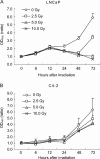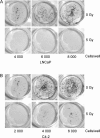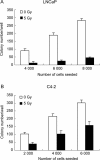The radiation response of androgen-refractory prostate cancer cell line C4-2 derived from androgen-sensitive cell line LNCaP
- PMID: 20118949
- PMCID: PMC3739257
- DOI: 10.1038/aja.2009.91
The radiation response of androgen-refractory prostate cancer cell line C4-2 derived from androgen-sensitive cell line LNCaP
Abstract
Radiation therapy is a relatively effective therapeutic method for localized prostate cancer (PCa) patients. However, radioresistance occurs in nearly 30% of patients treated with potentially curative doses. Therapeutic synergy between radiotherapy and androgen ablation treatment provides a promising strategy for improving the clinical outcome. Accordingly, the androgen deprivation-induced signaling pathway may also mediate radiosensitivity in PCa cells. The C4-2 cell line was derived from the androgen-sensitive LNCaP parent line under androgen-depleted condition and had acquired androgen-refractory characteristics. In our study, the response to radiation was evaluated in both LNCaP and C4-2. Results showed that C4-2 cells were more likely to survive from irradiation and appeared more aggressive in their resistance to radiation treatment compared with LNCaP, as measured by clonogenic assays and cell viability and cell cycle analyses. Gene expression analyses revealed that a set of genes involved in cell cycle arrest and DNA repair were differentially regulated in LNCaP and C4-2 in response to radiation, which was also consistent with the radiation-resistant property observed in C4-2 cells. These results strongly suggested that the radiation-resistant property may develop with progression of PCa to androgen-independent status. Not only can the LNCaP and C4-2 PCa progression model be applied for investigating androgen-refractory progression, but it can also be used to explore the development of radiation resistance in PCa.
Figures






Similar articles
-
Identification of novel androgen receptor target genes in prostate cancer.Mol Cancer. 2007 Jun 6;6:39. doi: 10.1186/1476-4598-6-39. Mol Cancer. 2007. PMID: 17553165 Free PMC article.
-
Androgen deprivation induces selective outgrowth of aggressive hormone-refractory prostate cancer clones expressing distinct cellular and molecular properties not present in parental androgen-dependent cancer cells.Cancer J. 2000 Jul-Aug;6(4):220-33. Cancer J. 2000. PMID: 11038142
-
Androgen responsive and refractory prostate cancer cells exhibit distinct curcumin regulated transcriptome.Cancer Biol Ther. 2008 Sep;7(9):1427-35. doi: 10.4161/cbt.7.9.6469. Epub 2008 Sep 4. Cancer Biol Ther. 2008. PMID: 18719366
-
Androgen receptor involvement in the progression of prostate cancer.Endocr Relat Cancer. 2003 Jun;10(2):209-16. doi: 10.1677/erc.0.0100209. Endocr Relat Cancer. 2003. PMID: 12790784 Review.
-
MicroRNAs in androgen-dependent PCa.Front Biosci (Landmark Ed). 2013 Jan 1;18(2):748-55. doi: 10.2741/4137. Front Biosci (Landmark Ed). 2013. PMID: 23276959 Review.
Cited by
-
The nrf1 and nrf2 balance in oxidative stress regulation and androgen signaling in prostate cancer cells.Cancers (Basel). 2010 Jun 21;2(2):1354-78. doi: 10.3390/cancers2021354. Cancers (Basel). 2010. PMID: 24281119 Free PMC article.
-
Prostate Cancer's Silent Partners: Fibroblasts and Their Influence on Glutamine Metabolism Manipulation.Int J Mol Sci. 2024 Aug 27;25(17):9275. doi: 10.3390/ijms25179275. Int J Mol Sci. 2024. PMID: 39273225 Free PMC article.
-
RelB regulates Bcl-xl expression and the irradiation-induced apoptosis of murine prostate cancer cells.Biomed Rep. 2014 May;2(3):354-358. doi: 10.3892/br.2014.250. Epub 2014 Mar 12. Biomed Rep. 2014. PMID: 24839547 Free PMC article.
-
The putative tumour suppressor protein Latexin is secreted by prostate luminal cells and is downregulated in malignancy.Sci Rep. 2019 Mar 26;9(1):5120. doi: 10.1038/s41598-019-41379-8. Sci Rep. 2019. PMID: 30914656 Free PMC article.
-
Radioiodine therapy for castration-resistant prostate cancer following prostate-specific membrane antigen promoter-mediated transfer of the human sodium iodide symporter.Asian J Androl. 2014 Jan-Feb;16(1):120-3. doi: 10.4103/1008-682X.122354. Asian J Androl. 2014. PMID: 24369144 Free PMC article.
References
-
- Jemal A, Siegel R, Ward E, Murray T, Xu J, et al. Cancer Statistics, 2007. CA Cancer J Clin. 2007;57:43–66. - PubMed
-
- Cooperberg MR, Broering JM, Litwin MS, Lubeck DP, Mehta SS, et al. The contemporary management of prostate cancer in the United States: lessons from the cancer of the prostate urologic research endeavor (CapSURE), a national disease registry. J Urol. 2004;171:1393–401. - PubMed
-
- Zelefsky MJ, Ben-Porat L, Chan HM, Fearn PA, Venkatraman ES. Evaluation of postradiotherapy PSA patterns and correlation with 10-year disease free survival outcomes for prostate cancer. Int J Radiat Oncol Biol Phys. 2006;66:382–8. - PubMed
-
- Pollack A, Zagars GK, Starkschall G, Antolak JA, Lee JJ, et al. Prostate cancer radiation dose response: results of the M.D. Anderson phase III randomized trial. Int J Radiat Oncol Biol Phys. 2002;53:1097–105. - PubMed
-
- Rosen EM, Fan SJ, Rockwell S, Goldberg ID. The molecular and cellular basis of radiosensitivity: implications for understanding how normal tissues and tumors respond to therapeutic radiation. Cancer Invest. 1999;17:56–72. - PubMed
Publication types
MeSH terms
Substances
LinkOut - more resources
Full Text Sources
Medical
Miscellaneous

